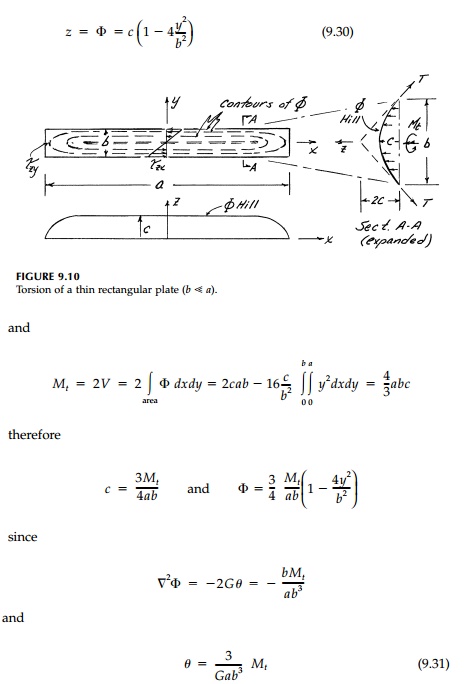Chapter: Civil : Principles of Solid Mechanics : Torsion
Torsion: Membrane Analogy
Membrane Analogy
The crucial step in the
stress-function approach, finding ¤Ľ, is not much easier
than finding a warping function w. Its advantage comes from the simple

boundary condition and, more importantly, the aid it gives in visualizing the stress-function hill by analogy. In his presentation in 1903, Prandtl* observed that the stress-function equation Ô▒»2¤Ľ= -2G╬Ş is the same Poisson type as that giving the elevation of an elastic membrane loaded by pressure on one side. While the computer with canned finite-difference or finite element solutions to PoissonÔÇÖs equation have replaced actual laboratory experiments with soap films, the membrane analogy is an extremely useful heuristic device to visualize the ¤Ľ surface and hence the stiffness of and the shear stresses on a cross-section under torque. In most cases, in fact, approximate calculations based on the membrane analogy are more than adequate for rough analysis and design.
As shown in Figure 9.8,
imagine a flexible membrane stretched flat over a hole in a flat plate of the
irregular shape of the cross-section to be analyzed. Air pressure is applied
and the membrane is stretched a distance z(x,y) above the
plate. Summing forces in the z direction:

gives the resultant shearing stress at any point.
Thus the tangent to any
membrane contour gives the direction of the result-ant shear with a magnitude
equal to the slope perpendicular to the contour line at that point. The
twisting movement

is twice the volume
under the membrane. Finally, if we consider vertical equilibrium along a
contour s,

When there is a hole in
the cross-section, the shear stress must be zero and the membrane must be flat,
corresponding to a weightless plate ÔÇťfloatingÔÇŁ on

the surface. For
example a solid cylinder is compared to hollow and split cyl-inders in Figure
9.9. Clearly, considering the weight reduction, removing the core of a solid
cylinder is a good design choice since the reduction in torsional stiffness and
moment capacity V1 compared to V2 (that
remaining) is small.* For the split ring in Figure 9.9 with a moment capacity
proportional to the volume of the small torus V3 , the
reduction is dramatic. If the wall thickness is small, a cut reduces the
capacity to where it is essentially that of a thin plate of thickness t
and length equal to the perimeter 2¤Çr.
In fact it is nearly correct for any thin-walled, open cross-section to
calculate its moment capacity and stiffness as the sum of its elements
considered as flat plates.
It is easy to solve for
a flat plate under torsion from the membrane analog. If b > t then, except near the ends, the shape of a nearly ÔÇťflatÔÇŁ membrane
under uniform vertical load on the horizontal projection is parabolic** as
shown in Figure 9.10. Thus

evidently the
ÔÇťtorsional constantÔÇŁ (i.e., the shape contribution to the torsional stiffness GJ)
is

This result can be
generalized to any thin-walled, open section such as shown in Figure 9.11. It
is approximately correct to say that the inflated mem-brane shape is parabolic
throughout except near the ends and at any corner. Since ╬Ş must be the same for each part then:

and the maximum stress
will occur where the thickness is a minimum in Equation (9.35).
Corrections for the end
and corner effects are possible using, for example, Fourier series or
experimental results. Today, however, numerical solutions to PoissonÔÇÖs equation
on the computer will generate results to any degree of precision. Such results
are shown in Table 9.1. It is interesting that computing power and more exact
solutions, if anything, only increase the necessity for the designer to
understand the membrane analogy in order to visualize the results and then
shape
Related Topics